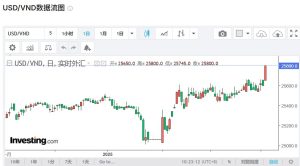The Storm: Trump’s 46% Tariff Hammer
In a seismic policy shift, the Trump administration imposed 46% reciprocal tariffs on Vietnamese goods effective April 5th, 2025, targeting key exports like textiles and footwear that constitute 7.1% of Vietnam’s GDP:cite[3]:cite[4]. This move comes as Vietnam’s trade surplus with the U.S. hit $1.23 trillion in 2024, second only to China and Mexico:cite[6]:cite[8].
“The tariff bomb instantly vaporized 7% of Nike’s market value and 10% of Lululemon’s stock overnight.” – Bloomberg Industry Analysis:cite[3]
Vietnam Dong in Freefall

The currency markets reacted violently, with the Vietnamese Dong plunging 4.2% against USD within 48 hours of the announcement. This currency crisis exposes Vietnam’s fragile economic position:
- 30% of exports destined for U.S. markets:cite[6]
- Manufacturing costs already 7-20% higher than China:cite[8]
- Power shortages forcing factories to cut production by 30%:cite[8]
China’s Offshore Dream Turns Sour
The tariff tsunami has devastated Chinese manufacturers who relocated to Vietnam during the 2018-2024 trade war:
| Sector | Impact | Source |
|---|---|---|
| Textiles | 80% raw materials imported from China:cite[8] | Vietnam Customs |
| Electronics | 50% Samsung production now stranded:cite[8] | WSJ Report |
| Footwear | $200B Nike/Adidas production at risk:cite[3] | Company Filings |
The New Calculus of Global Manufacturing
This crisis reveals three harsh realities:
- Tariff Arbitrage Dead End: Chinese firms relabeling goods as “Made in Vietnam” face 41.7% U.S. tariffs vs previous 3.4%:cite[8]
- Supply Chain Musical Chairs: 150+ Chinese manufacturers now considering secondary moves to India/Indonesia:cite[8]
- Cost Illusion Exposed: Vietnamese industrial park rents now match Dongguan while productivity lags 30%:cite[8]
No Safe Harbors in Trade Wars







